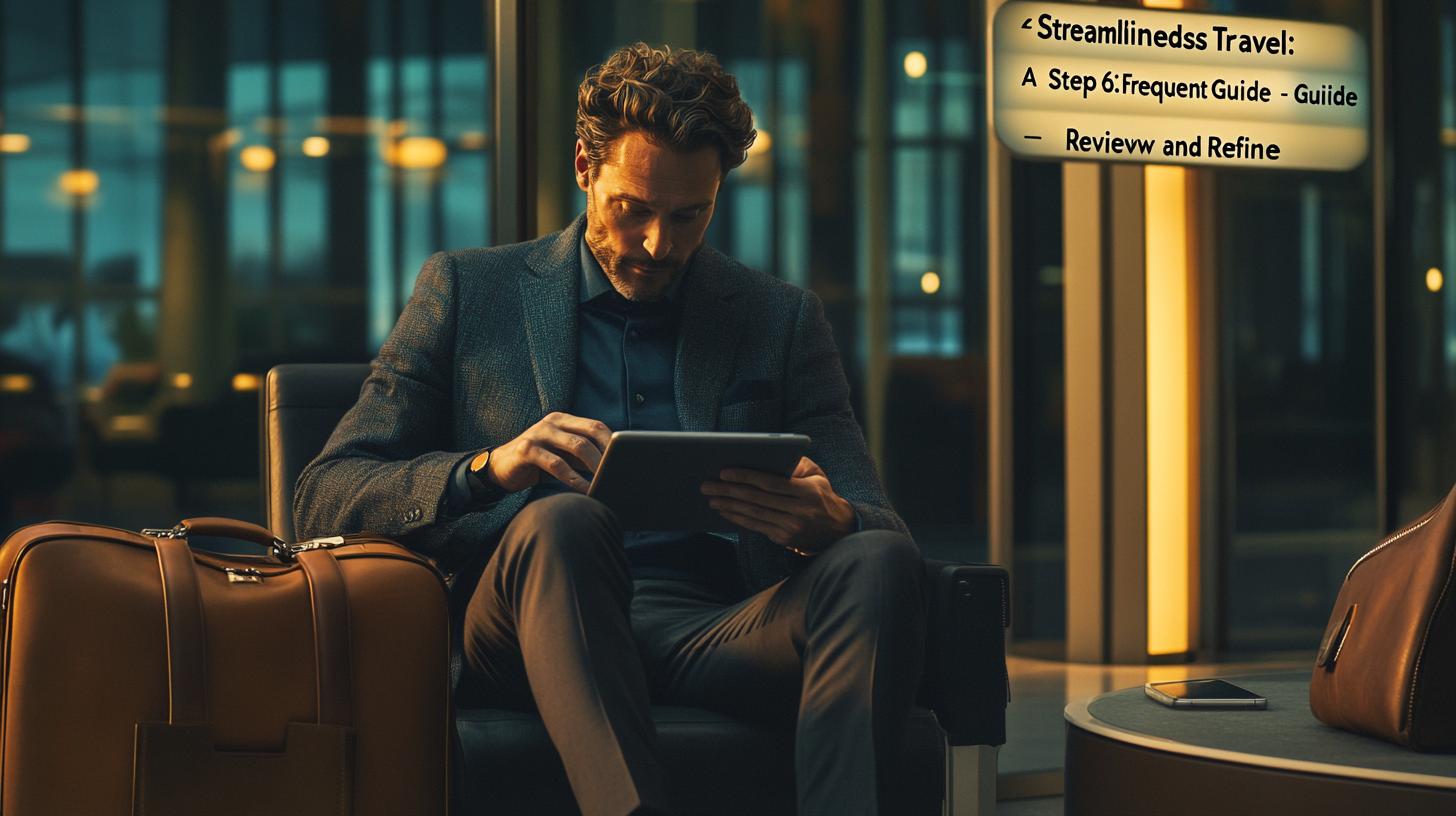Streamlined Business Travel: A Frequent Flyer’s Guide

Business travel these days is more than just boarding a plane and hoping everything goes smoothly—especially when many of us are juggling tight schedules and long to-do lists. I’ve spent quite a bit of time observing how organizations manage their corporate trips, and I’ve run into my fair share of surprises on the road. Over the years, I’ve found that having a strategic, research-driven approach makes a world of difference, allowing us to stay focused on the true mission: making meaningful connections and achieving real results.
Step 1: Outline Your Objectives And Budget

I’ve noticed that the most successful trips start with clarity about why we’re traveling in the first place. Whether it’s establishing new client relationships or attending a high-profile conference, I always ensure I know exactly what the end goal is. A recent study from the Global Business Travel Association found that companies saving around 20% on travel costs often designate clear mission statements for every trip, and I’ve observed similar benefits firsthand. Tight policies can be helpful, too: when you’re bound by a specific airline or hotel chain, the decision-making process becomes a lot simpler.
In my own travels, I’ve also learned to confirm the practical details well in advance—things like insurance policies, reimbursement paperwork, and relevant documentation. It’s amazing how many last-minute headaches can be avoided by doing a little homework. Professional resources, including a reader-approved wikiHow article updated in 2024, consistently emphasize the importance of planning for unexpected situations like lost luggage or sudden itinerary changes. I always keep digital copies of vital paperwork on my phone or cloud drive, ensuring nothing slips through the cracks.
Finally, I align the trip’s objectives and the budget before any flights are booked. By setting concrete goals—like signing a new client or finalizing a contract—and pairing them with a realistic spending outline, I’m far less likely to go off track. Some companies utilize cost-control strategies, such as pre-negotiated rates, so don’t hesitate to find out if you have access to budget-friendly options.
Step 2: Build a Comprehensive Itinerary

Now, when we talk about building an itinerary, it’s not just a list of flights and hotels. I’ve created itineraries with contingency plans baked in—if a flight is canceled, I already know which alternative route I can take. Industry experts like Jessica Freedman often advise maintaining multiple checklists for flights, accommodations, packing essentials, and key contacts. I find these lists indispensable, especially when dealing with multiple time zones or back-to-back meetings.
From my vantage point, the real key is centralizing all details—meeting agendas, addresses, and even personal notes. Whether that’s in a digital travel app or an old-school paper folder, having everything easily accessible helps me pivot quickly if something unexpected happens. Keeping adequate buffer times between layovers or important appointments has saved me from more than a few stressful dashes through international airports. For instance, after I once missed a connecting flight in Frankfurt due to a delay in the previous leg, I started building in at least an extra hour wherever possible.
A good itinerary does more than just keep you on schedule—it also ensures compliance with corporate policies. If your company has specific rules about booking through certain channels or only using approved hotels, factor those in early. By planning thoroughly, you gain peace of mind and maintain a professional impression, no matter what surprises pop up.
Step 3: Research and Book Early

I’ve long believed that timing is everything when it comes to snagging the best travel deals. According to industry data published in 2025, advance bookings can save up to 15% on airfare alone, which is significant if you’re coordinating multiple trips each quarter. By reserving flights, hotels, and rental cars early, you’re more likely to adhere to a set budget while still fulfilling your personal preferences—like window seats or easy access to conference venues.
I like to look at aggregated travel sites and see if corporate codes apply. If your company offers negotiation perks, it never hurts to ask. I once managed to secure a suite upgrade at no additional cost by simply mentioning that we had a long-standing corporate relationship. Forbes Coaches Council experts often recommend strategies like traveling light (capsule wardrobes work wonders) and preparing for possible delays by backing up digital files in cloud storage. These little tricks not only streamline the experience but also keep me adaptable when plans shift at the last minute.
For me, the biggest draw to early booking is the peace of mind. Rather than scrambling to find a decent flight or lodging option a few days before departure, I can review my reservations at my leisure, spot any errors, and rectify them without stress. This proactive attitude goes a long way toward maintaining my sanity on the road.
Step 4: Embrace the Right Tools

Managing modern business travel is nearly impossible without the right tech arsenal. I rely on dedicated apps that make everything from booking to expense reporting simpler. Platforms like Engine, TripIt, and SAP Concur are known for automating flight check-ins, offering real-time itinerary updates, and quickly generating thorough expense reports. By the time I arrive at a new destination, these tools have usually handled critical tasks behind the scenes.
From my perspective, real-time rebooking features are the real gems: there’s nothing worse than being stuck in an airport during a flight disruption only to see alternative flights filling up fast. With cloud integration, I can get new seat assignments or updated boarding passes sent directly to my digital wallet. For those who maintain a business website (or even a personal blog), WordPress plugins can help embed planning modules, track reservations, and keep vendor contracts in one place. With the advent of augmented reality travel experiences—something that’s growing in popularity—I foresee even more advanced tech coming our way, like virtual meeting rooms for mid-flight catch-ups with colleagues.
Ultimately, these innovations save time and stress, allowing me to focus on meaningful interactions—whether it’s with a new client or exploring an airport lounge that offers unique local treats. And if something does go wrong, technology can alert me immediately, giving me the freedom to take swift, informed action.
Step 5: Stay Flexible on the Road

Flexibility might be the single biggest asset in business travel. I’ve had flights delayed due to sudden storms, had to reroute for a last-minute meeting, and even changed hotels in the middle of the night when a reservation fell through. That’s why I keep an up-to-date emergency contact list and make sure I’ve got comprehensive travel coverage. Though these safety nets don’t prevent disruptions, they minimize the fallout.
To stay on top of shifting agendas, I communicate regularly with colleagues back home—whether it’s a quick email or a virtual meeting. Clear lines of communication mean I can respond right away if a client wants to move up a meeting or squeeze in an additional appointment. Industry experts suggest building spare time into each day precisely for these curveballs, and it’s advice I follow without fail. As a result, I feel more grounded—even when I’m zooming from one terminal to another halfway across the globe.
Another lesson I’ve learned is the importance of real-time expense tracking. I use digital solutions to log every significant transaction immediately. This not only helps me remain mindful of the budget but also provides an accurate account for after-trip analysis. Trust me: the fewer loose receipts you have stuffed in your backpack, the better.
Step 6: Review and Refine

After each journey, I take a meticulous look at what worked and what didn’t. Did the actual costs match my projected budget? Were the key objectives—such as product demos or client pitches—achieved? A recent survey of frequent business travelers indicated that 45% of them routinely adjust their strategies based on post-trip evaluations. That’s something I’ve taken to heart.
Sometimes, reflecting on a trip yields surprising insights: perhaps I realize I never used the lounge pass I paid extra for, or I discover I should’ve booked a hotel closer to a conference site rather than saving a few bucks on a cheaper property. This kind of introspection ensures that the next trip is even more efficient and fulfilling. I’ve also followed best practices from Forbes Coaches Council tips on staying healthy on the road—like carrying hydration packets and a portable phone charger—a small step that protects my energy and productivity during intense schedules.
By refining these processes over time, I have built a reusable template that now serves me and others. Whenever I plan a conference visit or a meeting-laden trip, I know exactly where to begin and which steps to follow to stay on target.
Final Thoughts

Business travel can feel like a high-stakes juggling act, but it doesn’t have to be overwhelming. By clearly defining objectives, crafting detailed itineraries, booking early, and embracing digital tools, you can transform a complex journey into a streamlined experience. Don’t forget to remain flexible, because disruptions are all but guaranteed in the world of frequent flying. Adapting on the go will keep your morale high and your trip on track.
Ultimately, consistent self-review is the real secret sauce to success. Each flight delay or unexpected layover can become a learning experience if you allow it to be. Refine your approach with every trip, and soon you’ll have a system that makes even the most elaborate travel itinerary manageable and rewarding.
Amelia Yeaher’s Take
From the vantage point of someone ever-curious about cutting-edge airline technology, I’ve seen how small adjustments in planning can reduce stress and boost productivity. Embracing innovation doesn’t just have to be about gadgets; it’s also about leveraging the best of what’s already out there—trusted data, forward-thinking resources, and meaningful partnerships in every city you land.
My favorite part of any journey is the chance to discover a new way of doing things, whether it’s test-driving an app that predicts flight turbulence or spotting a fresh trend at an airport lounge. The more I push boundaries, the better my overall travel experience becomes.
Seat5A is where you can find more insights like these.






